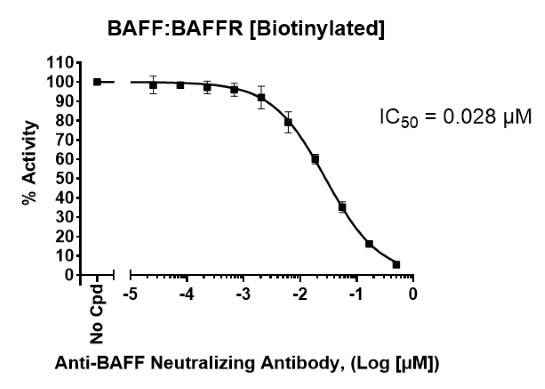BAFF:BAFFR [Biotinylated] Inhibitor Screening Chemiluminescence Assay Kit
The BAFF:BAFFR [Biotinylated] Inhibitor Screening Chemiluminescence Assay Kit is designed for screening and profiling molecules that block the binding between BAFF (B-cell Activating Factor) and BAFFR (BAFF receptor). This kit comes in a convenient 96-well format, with enough recombinant human biotin-labeled BAFFR (amino acids 23-71), BAFF (amino acids 134-285), streptavidin-HRP, and assay buffer for 100 reactions.

Figure 1: Illustration of the mechanism of BAFF:BAFFR [Biotinylated] Inhibitor Screening Chemiluminescence Assay Kit.
A 96-well plate is coated with BAFF protein. After blocking, the plate is pre-incubated with an inhibitor or neutralizing antibody. After incubation with Biotin-BAFFR, the plate is washed and Streptavidin-HRP is added. The ELISA ECL substrate is added, and the resulting signal can be measured using a chemiluminescence microplate reader. The chemiluminescence signal is proportional to the binding of BAFF to BAFFR.
Need us to run inhibitor screens or profile your compounds against BAFF:BAFFR? Check out our Immunotherapy Screening Services.
- 1x PBS buffer (Phosphate Buffer Saline, pH 7.4)
- PBS-T (1x PBS buffer with 0.05% Tween-20)
- Microplate reader capable of reading chemiluminescence
- Adjustable micropipettor and sterile tips
- Rotating or rocker platform
| Catalog # | Name | Amount | Storage |
| 100194 | BAFF, His-Avi-Tag* | 2 µg | -80°C |
| 100287 | BAFF-R, Fc Fusion (IgG1), Avi-Tag, Biotin-Labeled* | 5 µg | -80°C |
| 5x PP-02 Buffer | 4 ml | -20°C | |
| Blocking Buffer 7 | 40 ml | +4°C | |
| 79742 | Streptavidin-HRP | 10 µl | +4°C |
| 79670 | ELISA ECL Substrates A (translucent bottle) | 6 ml | Room Temp |
| ELISA ECL Substrates B (brown bottle) | 6 ml | Room Temp | |
| 79699 | White 96-well microplate | 1 | Room Temp |
*The initial concentration of both BAFF and BAFFR is lot-specific and will be indicated on the tube containing the protein.
The BAFF (TNF family ligand B-cell Activating Factor), also known as BLyS, TALL-1 or CD257, is encoded by the TNFSF13B gene and is a Type II membrane-bound protein, which can be released as a soluble ligand upon proteolytic processing. This cytokine is a ligand for the receptors Transmembrane Activator and CAML Interactor (TACI or TNFRSF13B), BAFF Receptor (BAFFR, or TNFRSF13C) and B-cell Maturation Antigen (BCMA, TNFRSF17). These interactions promote cell survival and play a crucial role in B cell development. In particular, BAFFR signaling is an important player in the later stages of B cell differentiation, including the survival of long-lived bone marrow plasma cells and likely for the survival of plasma blasts. BAFF signaling is also required for CCL (chronic lymphocytic leukemia) cell survival. Binding of BAFF to BAFFR results in the degradation of TRAF3 (TNF receptor associated factor 3), which stops the inhibition of SYK and results in activation of pathways necessary for B cells. It also activates the non-canonical slow NF-κB2-dependent pathway, which relies on the activation of NIK (NF-κB-inducing kinase). Targeting BAFF-BAFFR will open new therapeutic avenues in diseases related to these proteins.
Thompson J. S., et al., 2000 J. Exp. Med. 192(1): 129-136.
Bossen C., et al., 2006 Semin. Immunol. 18(5): 263-275.
Scheighoffer E. and Tybulewicz V., 2021 Curr Opin Immunol. 71:124-131.



